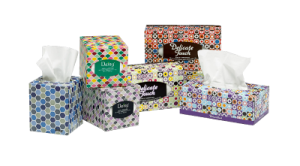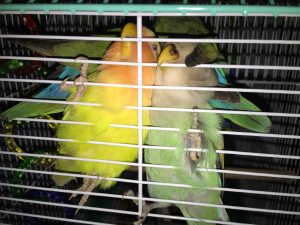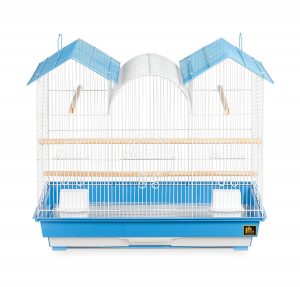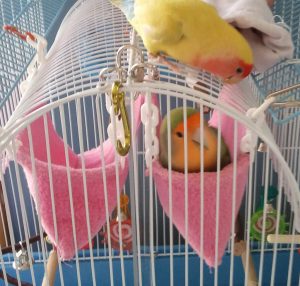New birds and rehomed birds are going to be drastically different in some ways but in many ways they will be the same. Tame rehomed birds come from a home where they had a pattern and a personality and certain stimuli and now all that has been altered or taken away. A baby bird is the same but since it never knew such stagnation and consistency it won’t know any better, but because of that, the baby bird will take more time to acclimate. However, if a rehomed bird came from an abusive or neglectful home, getting that bird to trust you can take a zen level of patience and love. As I stated earlier, if you win a birds trust they’re yours forever but you have to earn it. The good news is that there are things you can do to help this transition along. Planning in any situation goes a long way to achieving success.
For all bird owners, if I am ever to impart any piece of knowledge on to you, greater than the Tidy Seed food dish, greater than the JW – Insight water silo/high sand perch combination system for drinking water (both of which are in the “Food & Water Setup” chapter), the greatest asset you can have is facial tissue.  Kleenex. Where I’m from there is a local chain that sells Daisy brand 84 ct. facial tissues for $0.69 per box. We have 3 in the closet and 1 in all 3 rooms at all times. This will be your best friend. The fantastic price, as you can well imagine, comes with a “price” of its own. It’s certainly not Puffs or Kleenex name brand when it comes to softness but like most things in life, it certainly has its purpose. Especially if you’re a parront. It perfectly fine and dandy for the occasional booger but I certainly wouldn’t recommend it during a bout of the sniffles. However, for cleaning up birdie poopie, it’s the best product for the job. Find the best deal you can and buy in bulk. Cats have hairballs and litterboxes, dogs have piles out in your back yard, bird leave a little scentless greenish drop about half the size to the size of a pea about every 5-15 minutes. I’ll take the latter vs a protein eating animals’ stank stool sample. Always have a tissue handy and you’ll be in great shape. You can also benefit by picking it off your clothes or other surfaces in a pinch/pull motion, much like you’d use against a spider (minus the squishing part). Or how you’d use a paper towel to pick up bread crumbs or spilled salt off the floor if you didn’t have a dustpan. I’ve never seen it where bird droppings didn’t wash out of standard fabric but this way it at least won’t smear it into the clothing or fabric.
Kleenex. Where I’m from there is a local chain that sells Daisy brand 84 ct. facial tissues for $0.69 per box. We have 3 in the closet and 1 in all 3 rooms at all times. This will be your best friend. The fantastic price, as you can well imagine, comes with a “price” of its own. It’s certainly not Puffs or Kleenex name brand when it comes to softness but like most things in life, it certainly has its purpose. Especially if you’re a parront. It perfectly fine and dandy for the occasional booger but I certainly wouldn’t recommend it during a bout of the sniffles. However, for cleaning up birdie poopie, it’s the best product for the job. Find the best deal you can and buy in bulk. Cats have hairballs and litterboxes, dogs have piles out in your back yard, bird leave a little scentless greenish drop about half the size to the size of a pea about every 5-15 minutes. I’ll take the latter vs a protein eating animals’ stank stool sample. Always have a tissue handy and you’ll be in great shape. You can also benefit by picking it off your clothes or other surfaces in a pinch/pull motion, much like you’d use against a spider (minus the squishing part). Or how you’d use a paper towel to pick up bread crumbs or spilled salt off the floor if you didn’t have a dustpan. I’ve never seen it where bird droppings didn’t wash out of standard fabric but this way it at least won’t smear it into the clothing or fabric.
As for interacting with your bird, if you are getting a new bird or are rehoming an older bird, your best bet is to leave the bird be for the first 3 days. If it’s an older bird and it lifts the door with its beak or paces back and forth, giving a sign that it wants to come out then let them out but old bird or baby bird, have a plan in place for where they can go. (See “Play Area” Chapter) If it’s a rehome bird you MUST keep the original name, at least to start with until the bird trusts you as a member of its flock. Even if you’ve had a DNA test done and know for certain that you have a girl named Charlie or a boy named Sue. You wouldn’t change a 4 or 8 year old human child’s name or a foster child’s name for personal preference would you? Don’t change your bird’s name for your personal pleasures. That’s part of the deal of rehoming an older bird. My friend had a dog named Tuscon but after a while, before he became a full grown adult, everyone just started calling him Binky. He answered to both but that’s because the transition was over time and occurred slowly and into later on in his life. Otherwise you’ll have a “Toby/Kunte Kinte” scenario. The bird will be confused enough to start so once he trusts you then start saying the “hi Charlie, how’s my sweetie, how’s my little Binky, are you a good girl?” Then it should be all good. Otherwise, keep the name, especially if you’re going to try to train it or do things like tricks, flying to its cage or to poop on command. Most tricks work best like Simon Says if you say the bird’s name first to get it’s attention. You can’t do that if he doesn’t know his name.
After the bird gets accustomed to its new home you can slowly alter the name if you wish but you wouldn’t do that with a human so it shouldn’t be a big deal unless you’ve wanted a bird named X all your life, in which case you’d probably be getting a baby from a breeder. If the bird is a brand new baby let it sit in the cage for at least 3 days before you even think about trying to put your hand in there. You can get fake hands at Halloween shops to zip tie to the outside of cage so the bird becomes accustomed to hands faster. Just make sure it doesn’t have that nasty plastic scent to it or paint that the bird can peel off and get poisoned by. It’s a good idea to wash that and ALL TOYS or anything it might play with or put in its mouth, especially if it’s used which is generally not recommended if you can help it. Just buy new unless it’s a unique item that can be sterilized with rubbing alcohol (then rinsed thoroughly). As for birdie’s first few days, don’t bother the bird. Go about your normal business and when the bird starts to notice you and/or feel comfortable in its surroundings then you can start to put your hand in if needed. Wait 3 days though at least. Unless you’re changing food or water but if you have the Tidy Seed food dish and the JW Insight bird water silo, you don’t need to worry about that. *WBDL (will be discussed later) about how to set up the cage so that you can do both without ever opening the cage door.
I know the temptation to grab that cute little ball of fluff and smother them with hugs & kisses will be challenging. Birds, especially lovebirds, especially BABY lovebirds are super SUPER cute and you want to snuggle them all the time but DO NOT invade the bird’s privacy until it gets over its fear of its new environment. Don’t bother them prematurely or you may have trust issues that can take a long time to correct. You can say “Hi *name*” in a soft voice when passing but don’t park there and freak it out with your huge human eyes peering into the cage. The bird may exhibit frightened behavior. Remember, it’s not like dogs that have been man’s best friend since we lived in caves. Birds as pets have been going on for a handful of generations at best. It’s still a wild animal that has no idea what you are other than big and frightening.
 He may cling to the side of the cage or stand on something and lean up against the cage and facing the wall with its eyes somewhat closed. He will look as if he’s in fear because he is so scared that he is literally doing everything possible to make it all go away. This will generate the biggest “poor little guy” feeling you’ll ever have in your entire life. Unless you’re a Chicago Bears fan… then that’s an automatic. (Sorry. I’m a Packer fan. I had to lol) You will never feel so helpless. Do not worry, this is normal and it should pass within a couple of days. Just like when you drop your first kid off at pre-school or kindergarten. I’m sure you cried then too, same scenario. Hence the 3 day rule. If the bird continues to do it after 3 days then only put your hand near to clean and feed. Talk to him, say hi, talk soft like you talk to a baby. You don’t have to high pitch and gaa gaa goo goo but softly. There are many training and other videos online that can be a great resource for info, trust and training methods but your best tool will always be education and observation. Just like being at the doctor… you know your child better than anyone. Same in dealing with the vet, you’ll learn to know your bird better than anyone but this will take time. Be patient.
He may cling to the side of the cage or stand on something and lean up against the cage and facing the wall with its eyes somewhat closed. He will look as if he’s in fear because he is so scared that he is literally doing everything possible to make it all go away. This will generate the biggest “poor little guy” feeling you’ll ever have in your entire life. Unless you’re a Chicago Bears fan… then that’s an automatic. (Sorry. I’m a Packer fan. I had to lol) You will never feel so helpless. Do not worry, this is normal and it should pass within a couple of days. Just like when you drop your first kid off at pre-school or kindergarten. I’m sure you cried then too, same scenario. Hence the 3 day rule. If the bird continues to do it after 3 days then only put your hand near to clean and feed. Talk to him, say hi, talk soft like you talk to a baby. You don’t have to high pitch and gaa gaa goo goo but softly. There are many training and other videos online that can be a great resource for info, trust and training methods but your best tool will always be education and observation. Just like being at the doctor… you know your child better than anyone. Same in dealing with the vet, you’ll learn to know your bird better than anyone but this will take time. Be patient.
Once the bird starts warming up, start interacting with him. When you’re ready to let him come out, open the door and let him come out on his own. Remember, that is cage his home just like your home is yours or if you’re a kid or a roommate in a shared space, your room is YOURS. You don’t want people you don’t know grabbing at your stuff. You don’t want to go grabbing in there for him. Forcing snuggles does not work. You’ll probably have to get him back into the cage at some point so you’ll be doing the grabbing/scooping at him then. (That is discussed in the “Grabbing Your Wobbler/Catching Your Flyer” Chapters) If you don’t live alone, have one of you turn the light off quick while the other takes 2 hands and cups the bird. You cup it like you’re grabbing a raw egg. Eggs are delicate but can be tossed and juggled with the right handling and care. But try to avoid reaching in to grab the bird while he’s in his cage. When they’re ready they’ll come out and when they’re ready to greet you they’ll come by. Enticing them with millet or sunflower seeds doesn’t hurt. But… this is where you need to have your play area and how a flighted AND a clipped bird will get to those play areas, planned far in advance. A bird, dog, kid… or husband for that matter, is MUCH happier when he knows his boundaries and when he can live a happy life without getting scolded… you have bliss. As much as you can have in a “confinement” scenario ☺
However, once your bird is past the 3 day mark, what I will recommend, especially at night is to take the bird out of its cage when it’s sleeping and put him under your flannel or sweater. This is why I chose the cage I did, aside from the size & dimensions.

The Prevue Triple Roof Bird Cage.
The Prevue has a main door (that perfectly fits a bird bath) and 2 side doors and the roof is accessible on each side. This makes setup, cleaning and treat divvying much easier. Not to mention grabbing your baby birdie for snuggle time since the sleeping hut will be right by the water silo and near the food dish. This way you can take the roof off and access your bird. Have a flannel shirt with a pocket specifically for your bird to better help you bond with it. That will be explained in the “Bonding” chapter.

Holly bugging Herbie who’s snug in his Cozy Cot.
It has an even split design, right down the middle so that you can use it for 2 birds with plexiglass as the divider. This can be used to separate birds who are hormonal or just don’t get along all the time.
